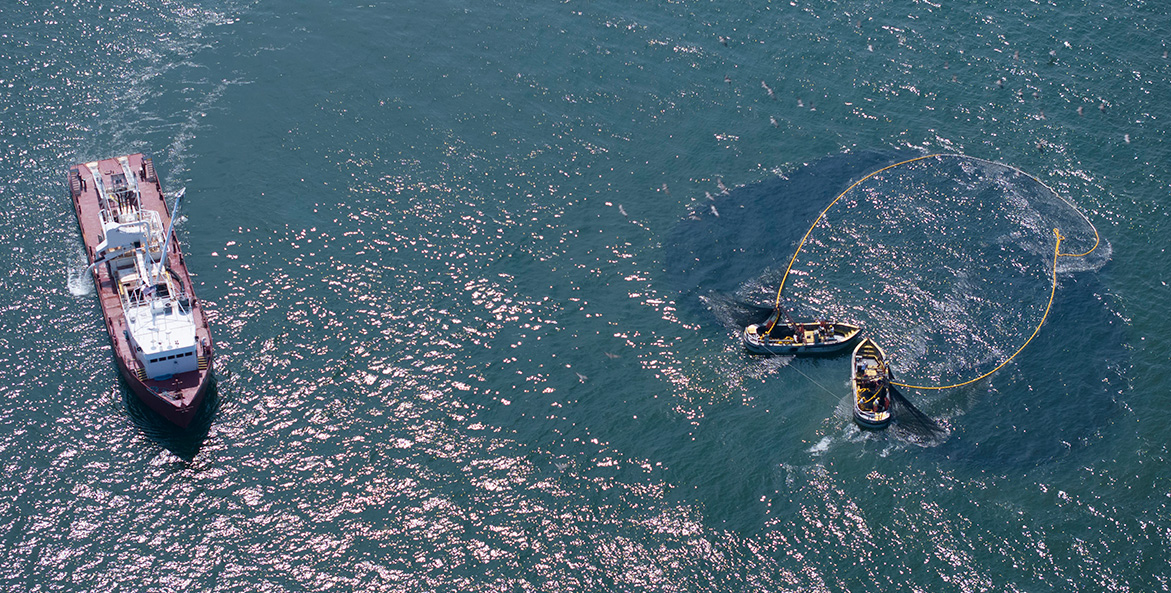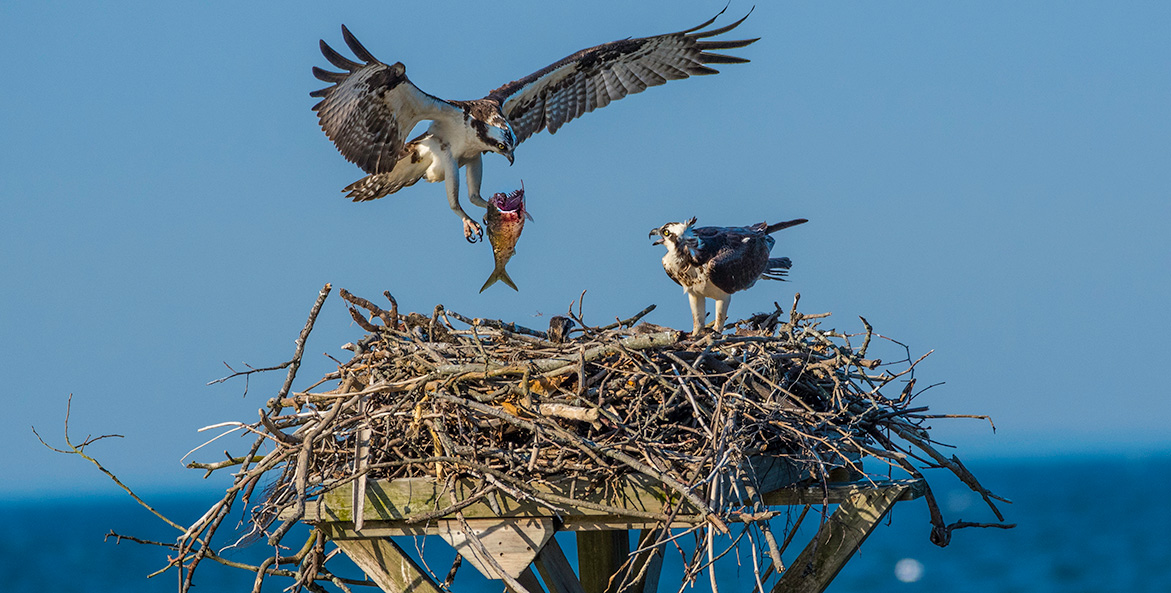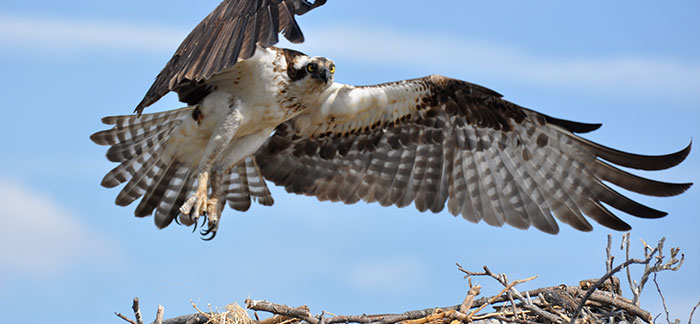Will they or won’t they? That’s the big question for the upcoming meeting of the Atlantic States Marine Fisheries Commission’s (ASMFC) Menhaden Management Board on May 7. Menhaden, a small, oily, nutrient-dense fish that is a critical prey source for Chesapeake Bay predators like osprey and striped bass has been a hot topic of conversation recently at ASMFC. Faced with concerning trends of increasing osprey nest failures and falling menhaden harvests, the Board launched a workgroup in August 2024 to investigate options that could leave more menhaden in the Bay for these predators.
After nearly 10 months of work, the workgroup released its final report: Precautionary Management of Chesapeake Bay. Workgroup members collected all the available data relating menhaden’s ecological role, menhaden fisheries, and the specific forage needs of osprey. The report includes promising potential management options designed to make sure there are enough menhaden available for predators at critical times of year.
In fisheries, precautionary management promotes risk-averse strategies when management or scientific uncertainties are high. The precautionary management approaches identified by the workgroup stand to benefit Chesapeake Bay’s menhaden, the predators that depend on them, commercial bait fishermen, and all of us striving for a restored Bay. Now, we must make sure the report results in productive action on Chesapeake Bay menhaden management.
CBF tracked the work group’s progress over nearly a dozen meetings, providing input along the way. This was no easy directive, and considering the limited availability of data on the number and movement of menhaden in Chesapeake Bay, the workgroup did as good a job as they could have.
Quite simply, menhaden are foundational to a healthy Chesapeake Bay and productive ecosystems throughout the Atlantic coast. Unfortunately, here in the Chesapeake Bay, menhaden science is incredibly lacking. Omega Protein, the single industrial company removing most of the menhaden out of the Bay, has repeatedly blocked studies on menhaden in the Bay, just as real concerns about the health of the menhaden population are mounting.

Commercial netters encircle a large menhaden school as the Omega Protein mothership approaches.
Theodore Roosevelt Conservation Partnership and CosmoVision Media
The report outlines numerous paths forward that explicitly address the foraging needs of predator species and considers the immense uncertainties around menhaden.
The workgroup memo, organized into an Executive Summary and a 50-page Source Document, provides precautionary management strategies for the Board’s consideration, including:
- Seasonal Closures: Much of the discussion around this subject focused on the times of year when osprey expend lots of energy and need more fish-calories. Osprey researchers identified May 1 to August 15 as the most demanding period for the bird as they’re raising baby osprey and have more mouths to feed. There are several options that consider closing or limiting menhaden fishing during all or part of this period. These months are also when redfish, striped bass, and speckled trout are in the Bay, thus those fish also stand to benefit.
- Area Closures: The options identified in this section would close off specified areas of the Chesapeake Bay from menhaden fishing as a way to reduce impacts to predator species and the ecosystem. Area closures range from just one of the osprey nest study sites, a broader combination of study areas, the entire Bay, and/or the mouth of the Bay.
- Effort Controls: The idea here is to explicitly distribute menhaden fishing effort and removals throughout the year. For example, managers could specify harvest limits for each month, which could offer relief to certain predator species that are more vulnerable or reliant on menhaden at distinct times of year.
- Decreasing the Bay Reduction Fishery Cap: In 2006, the ASMFC established the Chesapeake Bay Reduction Fishery Cap, which limits the number of menhaden removed from the Bay by the single reduction fishing company, Omega Protein. While this limit is precautionary in nature, it is essentially based on historic landings. We have no scientific basis as to what a biologically based limit should be to support the Bay’s ecosystem. The workgroup identified the fishery cap as a viable option to be more precautionary in the Bay. Just as the cap was reduced in 2017, the Management Board could simply further reduce the cap if seamless conservation is truly the goal.
One of the thorniest issues tackled by the workgroup, and one on which they did not reach consensus, is how any of the above approaches would be implemented and which fishing sectors would be included. There are significant drawbacks to including small-scale bait fisheries in closures, as they have less flexibility to move their fishing gear offshore or find other areas to fish. The larger Omega Protein vessels already fish offshore as far north as New Jersey so are less likely to be severely impacted. Ultimately, the work group deferred this discussion to the Board as a matter of policy.
Considering the lack of available menhaden data in the Bay due, in part, to suppression by Omega Protein, the workgroup did a standup job. It produced a well-researched document with viable management strategies protective of the Bay’s predators that depend on menhaden.
We truly hope that the rest of the ASMFC members take the time to review the entirety of the workgroup’s extensive report and give it the consideration it deserves. The Bay is a national treasure, and resource managers should be doing anything they can to remedy the dramatic declines in osprey reproduction, support striped bass, and acknowledge rapidly changing environmental conditions in the Bay. This report sets the stage for positive action on menhaden this year, and we’re looking forward to a productive discussion at the May 7 Menhaden Meeting. We must make sure this work doesn’t die on the vine or fall victim to Omega Protein’s influence like the Menhaden Study Plan has in Virginia. Stay tuned for another update after the ASMFC Spring Meeting.
Meeting Update: The ASMFC's Menhaden Management Board met in early May 2025 to review the Work Group's report and consider next steps for how management can benefit this forage species and the broader Chesapeake Bay ecosystem. Board members from throughout the Atlantic coast discussed the merits of the report and the challenges, namely the lack of Chesapeake Bay-specific data and the complexity of the report. This was a productive conversation, and there appeared to be genuine interest and concern for what's happening in the Bay. Ultimately, however, board members elected to delay a decision on next steps until later this summer, which could result in additional technical analysis. The opportunity for ASMFC to manage Chesapeake Bay menhaden more conservatively to safeguard the Bay's broader ecosystem remains in play, but at a slower pace. See our Menhaden web page for future updates.




